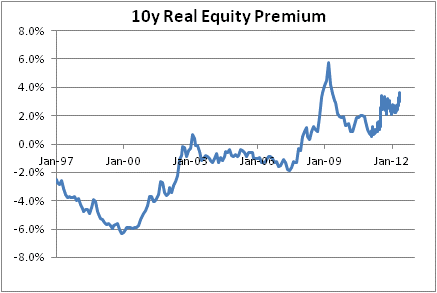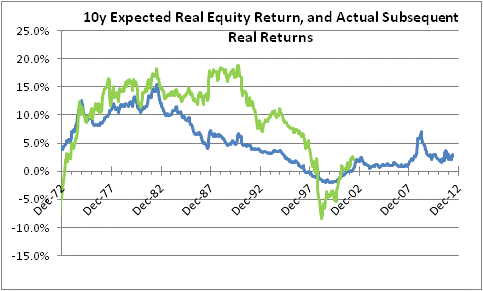The only thing that kept yesterday from being Freaky Friday is that it wasn’t Friday. But it certainly seemed as if everything was reversed suddenly between when we went to bed Tuesday night and when we woke up yesterday morning. U.S. equity futures were up 15 points before we woke up, and 38 points above the lows set on Sunday night. Plainly, some traders were either covering shorts or initiating longs before the ECB meeting.
But incredibly…the ECB did not cut rates. In fact, they did almost nothing (and certainly nothing that wasn’t fully expected). Putting on my monetary policymaker hat, I can’t think of any reason for not cutting rates if they actually believe what they profess to believe about economic growth and inflation.
Obviously they’re not really worried about deflation, because if they were worried about that then they’d be aggressively cutting since if inflation gets to zero before rates get to zero, it means you can’t ever make real policy rates negative. And they clearly don’t really believe that inflation, using that tired policymaker phrase that Draghi produced again yesterday, is constrained by “firmly anchored” inflation expectations,[1] because if they did then they wouldn’t have any concerns about triggering inflation through adding too much liquidity. True, cutting interest rates doesn’t provide much stimulus compared to a trillion euros of LTRO, but it is at least a relevant signal.
On the other hand…we already know that Draghi is no Trichet. And we know that under Draghi the money supply is already growing more-briskly (although not exactly briskly) than it did under Trichet, and the current ECB President has done some distinctly non-Bundesbank sorts of things. Maybe keeping rates at 1% are just the cheapest “hawk” credentials he can buy?
I am sure I am coming across as flustered and confused – because I am. I felt like I had had a bead on what was going on, and yesterday doesn’t fit my mental paradigm.
The overnight curious rally turned into a daylight furious rally as the market continued to melt up on light volume (760mm shares) throughout the day yesterday, despite the ECB’s relative intransigence and no other news of note. It was nothing short of a desperate grab for risk assets of all stripes as the euro rallied, the DJ-UBS Commodity Index jumped 1.4%, European stock markets soared, benchmark financial bond spreads tightened 20-30bps despite the downgrade overnight of German and Austrian banks by Moody’s, and yield spreads of periphery bonds compressed (10bps for Spain, 7bps for Italy, 21bps for Portugal in the 10y area).
But why? I feel like the kid who keeps bleating questions until Dad throws up his hands in exasperation and says “because I said so!” Maybe there isn’t an answer, but I wonder if some investors are buying or hedge funds covering short bets just on the thought that Bernanke today might be dovish when he testifies before Congress at 10:00ET. It just seems like there’s more conviction when buyers are chasing the stock market 2.3% higher than it was Tuesday, with no additional information except that the ECB is not easing as aggressively as they might have.
Now, the real equity risk premium, which we define as the expected 10-year real return of equities compared to the real return on 10-year TIPS, did advance a couple of days ago to the highest level in a couple of years. That’s significantly because TIPS yields are low, though, rather than equity returns looking particularly robust. However, I can imagine that some investors who were overweight in fixed-income might have chosen yesterday to get into equities, thinking that the spike low in yields was not likely to persist. That seems like a rotten reason to get into a risky asset class – just because the safe asset classes don’t offer big returns – but there are definitely investors who think that way.
Stock bulls, hold your water when you look at the next chart (Source: Enduring Investments):
Realize that although it appears that equities offer the best value relative to TIPS that has been seen since a brief period in early 2009, and more than has been seen for many years before that, we are looking at a period in which equities were congenitally overvalued. TIPS yields only go back to 1997, so I can’t look at the real equity premium from the early 1990s, or the 1980s. However, I can look at the expected 10-year equity real return from back then (and further), using the same methodology I use to produce the numbers in the chart above.
The result is not as exciting. The chart below (Source: Enduring Investments using Shiller data) shows that the current projected forward real return of 2.8% is only interesting in the context of the last decade and a half, and only in the context of the poor range of investing alternatives. I included the actual subsequent real return, with dividends reinvested, that is associated with each point up to May 31, 2002 (which 10-year period just finished with a compounded real return of 2.01%).
With the exception of the equity bubble, which produced better-than-expected returns for cohorts starting in the late 1980s and worse-than-expected returns for cohorts starting in the late 1990s (but, you already knew that), the method has a pretty decent track record since 1972. So, while equities are a better real asset than TIPS right now, that’s not saying a whole lot!
None of that solves the conundrum of why stocks spiked yesterday, but it makes me feel better by reminding me to keep focusing on the long-term! There will be wiggles, and my guess is that the next downward wiggle in stocks and upward wiggle in bonds won’t be long in coming. As soon as today, a bad Claims number (Consensus: 373k from 383k) could set a bad tone. Here’s a surprising statistic: since February 17th, economists’ estimates have been lower than the actual Claims figure – including subsequent revisions, that is – for every week but one. If Claims actually rise from 383k, it is bad news since we ought to be well beyond the weather give-back by now.
However, any reaction on Claims will be tempered by the fact that Bernanke’s testimony begins at 10:00ET or so. That clearly is the important event of the day, and it seems investors are quite confident that Ben will have cheerful things to say about the nearby course of monetary policy. After the ECB whiffed yesterday, I am not so sure.
While I think policymakers will respond with alacrity in the event of an actual emergency, I don’t think they are prepared to try to be pre-emptive (and anyway, if they tried to be pre-emptive and failed because Europe imploded anyway, it would look bad). So while the Chairman may be generous with his assessment that “we stand ready to help,” I don’t imagine we’ll get enough concrete promises that the market’s bounce will be validated.
[1] “Firmly anchored inflation expectations” are to monetary policymakers what “auras” are to ghost-hunters. It’s not possible to disprove that expectations are anchored, if you believe they are, because we don’t have any way to measure them one way or the other. But their existence is very important to the believers.
- English (UK)
- English (India)
- English (Canada)
- English (Australia)
- English (South Africa)
- English (Philippines)
- English (Nigeria)
- Deutsch
- Español (España)
- Español (México)
- Français
- Italiano
- Nederlands
- Português (Portugal)
- Polski
- Português (Brasil)
- Русский
- Türkçe
- العربية
- Ελληνικά
- Svenska
- Suomi
- עברית
- 日本語
- 한국어
- 简体中文
- 繁體中文
- Bahasa Indonesia
- Bahasa Melayu
- ไทย
- Tiếng Việt
- हिंदी
Curious Becomes Furious
Latest comments
Loading next article…
Install Our App
Risk Disclosure: Trading in financial instruments and/or cryptocurrencies involves high risks including the risk of losing some, or all, of your investment amount, and may not be suitable for all investors. Prices of cryptocurrencies are extremely volatile and may be affected by external factors such as financial, regulatory or political events. Trading on margin increases the financial risks.
Before deciding to trade in financial instrument or cryptocurrencies you should be fully informed of the risks and costs associated with trading the financial markets, carefully consider your investment objectives, level of experience, and risk appetite, and seek professional advice where needed.
Fusion Media would like to remind you that the data contained in this website is not necessarily real-time nor accurate. The data and prices on the website are not necessarily provided by any market or exchange, but may be provided by market makers, and so prices may not be accurate and may differ from the actual price at any given market, meaning prices are indicative and not appropriate for trading purposes. Fusion Media and any provider of the data contained in this website will not accept liability for any loss or damage as a result of your trading, or your reliance on the information contained within this website.
It is prohibited to use, store, reproduce, display, modify, transmit or distribute the data contained in this website without the explicit prior written permission of Fusion Media and/or the data provider. All intellectual property rights are reserved by the providers and/or the exchange providing the data contained in this website.
Fusion Media may be compensated by the advertisers that appear on the website, based on your interaction with the advertisements or advertisers.
Before deciding to trade in financial instrument or cryptocurrencies you should be fully informed of the risks and costs associated with trading the financial markets, carefully consider your investment objectives, level of experience, and risk appetite, and seek professional advice where needed.
Fusion Media would like to remind you that the data contained in this website is not necessarily real-time nor accurate. The data and prices on the website are not necessarily provided by any market or exchange, but may be provided by market makers, and so prices may not be accurate and may differ from the actual price at any given market, meaning prices are indicative and not appropriate for trading purposes. Fusion Media and any provider of the data contained in this website will not accept liability for any loss or damage as a result of your trading, or your reliance on the information contained within this website.
It is prohibited to use, store, reproduce, display, modify, transmit or distribute the data contained in this website without the explicit prior written permission of Fusion Media and/or the data provider. All intellectual property rights are reserved by the providers and/or the exchange providing the data contained in this website.
Fusion Media may be compensated by the advertisers that appear on the website, based on your interaction with the advertisements or advertisers.
© 2007-2025 - Fusion Media Limited. All Rights Reserved.
